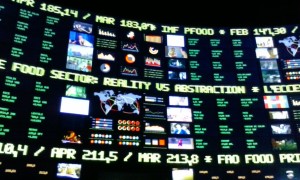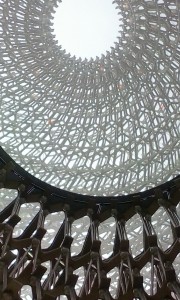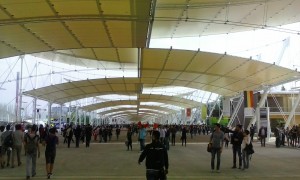Expo 2015: ‘Feeding the planet, Energy for life’ opened this month in Milan, more or less on time, but not without controversy. The opening day saw riots in opposition to the cost of the exhibition; costs also condemned as hypocritical by the Pope who suggested they might be put to more practical use in tackling the theme.
But with the exhibition now under way, it is more important to focus on the opportunity it presents. The theme, emphasising food security, is an urgent one and follows recent laudable World Fair themes centred on a fairer, sustainable future. 140 countries are present, either with its own pavilion or as part of a ‘cluster’ of countries organised by agricultural characteristics: Rice, Fruit & Legumes, Arid Zones etc. The 1.1 million square metre site and its diverse, elaborate and inventive architecture is magnificent (and built with sustainability in mind, we are assured). Each ‘cluster’ is complemented by an art or photography exhibition and inside the pavilions there is a glut of creative investment. The combination of political, technological and artistic achievement and collaboration is extraordinary.
And yet, practical and innovative engagement with the theme is minimal. The presence of the UN, spanning the whole exhibition for the first time, with a focus on its Zero Hunger Challenge, is excellent and informative but this essentially serves only to make the dominating, self-congratulatory national and corporate presence more distasteful.
Another valiant effort to present the harsh reality is found in the Slow Food pavilion, encouraging active thought about the importance of food and biodiversity. It is humbling, vital and, when I complete the mile from the main entrance to get there, empty. 100 yards away, every table is full with visitors enjoying their dinner – at McDonald’s. The company’s sponsorship of the event has, quite rightly, been ridiculed.
Many of the country pavilions are little more than a relocation of the nation’s tourist board, but there are some exceptions and all are entirely unique. From time to time, there are fascinating insights, from traditional sustainable water management techniques in Oman to soil solarisation methods supporting smallholders in Bangladesh. The UK’s construction is a giant beehive, an art installation connected to an actual hive that lights up and hums with the activity of the bees, exalting the contribution to food security these creatures offer. No substantial information is exhibited, however, and certainly no mention made of the UK’s unpopular position on the health of bees in the EU.
The US pavilion is, predictably, bigger, more straightforward, impressively and extensively ‘on theme’ but, ultimately, falsifying more emphatically than anyone else. It is difficult to excuse the championing of small farmers, organic production and equal access to food globally when those Americans genuinely pushing for these are so stifled by the country’s Congress. With similar predictability, the mighty Italian ‘Palazzo’ is bold and proud. The first few rooms are simply a disorienting series of mirrors (though smoke free), but eventually we are presented with a fascinating presentation of innovation for food security, from precision farming to miracle figs, from ‘plastic’ made from bio-waste to rivers as a clean source of energy.
The visit ends with a presentation of the Milan Charter, a broad-ranging piece of local legislation designed to establish the universal right to food in the city. It was exciting to see a movement that so closely resembles some of the current goals of Nourish, and, finally, the opportunity for practical engagement so lacking throughout the exhibition, albeit merely with a signature of support.
For all these reservations, the exhibition, and its intentions, is surely a positive thing. More disheartening than the lack of possibilities to engage with the theme was the apparent lack of interest in doing so. Visitors seemed thrilled by the chance to sit in a giant tractor, run up and down incongruous feats of architecture and enjoy overpriced food of undisclosed provenance, but those stopping to read were few, those talking to country representatives perhaps fewer still. I can hardly count myself among the latter, mind, frustrated by the staff having been employed for their language skills rather than their expertise on the theme.
These are still very early days for the Expo and, as the Director-General of the FAO, José Graziano da Silva, expects, “it will present a good opportunity to discuss” the future of food security, with many more events, pavilions, collaborations, visitors and protests perhaps to come. But progress? Ultimately that will suffer from this corporate bodycheck, this Milanese masquerade.
Charlie Hanks is co-director of The Real Junk Food Project Edinburgh and a regular contributor to the Nourish news blog.


